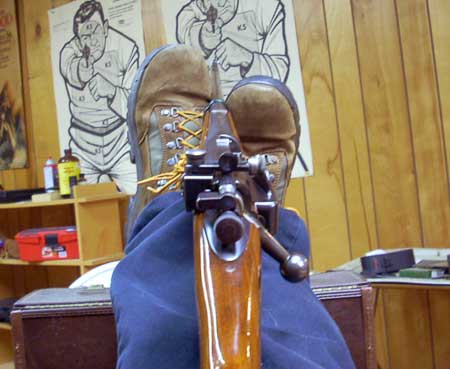From James Rummel:

Some Chicago Boyz know each other from student days at the University of Chicago. Others are Chicago boys in spirit. The blog name is also intended as a good-humored gesture of admiration for distinguished Chicago School economists and fellow travelers.
Comments are closed.
Nice picture–if I had to guess it’s a 1903 30-06 Springfield Rifle. Looks in great shape-a collector’s item.
Or a 30-40 Krag.
It is, indeed, a Krag. A sporterized example of a surplus military rifle.
That picture was taken in my basement classroom, and the rifle was used in my charity work.
I posted the Springfield after a quick look. Then, upon a closer look I saw the magazine on the side which was chacteristic of the Krag. I had one that I got years ago from Karl Hess, who was Goldwater’s speech writer before becoming a Libertarian. I since sold it to a friend who collects US military weapons–Krags, Springfields,M-1s, 1911 Colt .45s. Yours looks in great shape.
“Yours looks in great shape.”
Thank you for the kind words.
It is a great looker, but a previous owner shot some corrosive ammo through it, and then left it somewhere without cleaning. That fancy micro-meter sight on it is pretty much just for show, because the point of impact wanders around some if you are trying for a target beyond 100 yards or so.
A krag-jorgensen in 6.5 X 55 was the least accurate rifle I ever owned. A solid 18-MOA shooter, it would not have grouped on a watermelon at 100 yards, assuming you wanted to shoot a watermelon, which actually I would, since living they taste awful but dying they do very well, with a detonative flair. A shame that rifle was such a pissant platform because the cartridge punches above its weight; more alg have fallen to that mild-kicking long-dong 160-grain bullet than to any other.
The Krag was the US rifle in the Spanish-American War. Teddy Roosevelt, if I remember correctly, got the Army to buy the Mauser action rights which became the Springfield. Correct me if I’m wrong but I believe that is how it went down.
“Teddy Roosevelt, if I remember correctly, got the Army to buy the Mauser action rights which became the Springfield.”
I’m not sure myself, but I think that is what happened.
If you are looking for accuracy, look to handloading your own, using “oversize” cast bullets.
“oversize” simply means bigger than .308 that the copper jacketed factory rounds.
Folks shoot .312 and .310 cast rounds with great accuracy through ” shot out” bores all the time.
http://castboolits.gunloads.com/ is a great forum.
Good luck!
The Springfield ’03 was an American-designed rifle, or so the Ordinance Department claimed. However, after a series of secret negotiations with Mauser attorneys, the US paid Mauser $200,000 (a lot of money in those days) over 4 years beginning in 1905, to settle patent infringement claims on the rifle and the ammo clip.
If you’re interested in the history of US military rifles and the politics involved in all their aspects, I highly recommend “American Rifle” by Alexander Rose, copyright 2008.
http://www.amazon.com/American-Rifle-Biography-Alexander-Rose/dp/0553384384/ref=sr_1_1?ie=UTF8&s=books&qid=1262057815&sr=1-1
Another good book about military weapons is Misfire, by William Hallahan.
http://www.amazon.com/Misfire-William-H-Hallahan/dp/0684193590
It’s out of print but still available. It has a lot of semi-humorous stories about how the military would never trust soldiers with rapid fire because they were convinced they would waste ammunition. This led to the rejection of the Henry repeating rifle which would have ended the Civil war in a year. He points out that the South never had the industrial capacity to make the cartridges for the Henry. Without the cartridges, the rifle would have been useless to them whereas they rearmed themselves with muskets from the battlefield the entire war. A few units armed themselves with Henrys through subscription and they had devastating effect in combat.
He also has the story of the M 16 in which the Army changed the source for the powder that had been used in the Ar 15, which did not require cleaning. As a result, the M 16 came without a cleaning kit when it was first introduced. The result was jammed rifles in combat. I have read that a lot of dead US troops were found with jammed M 16s in Vietnam.
From reviews on the net,we know that MBT shoes will improve your posture
From reviews on the net,we know that MBT shoes will improve your posture